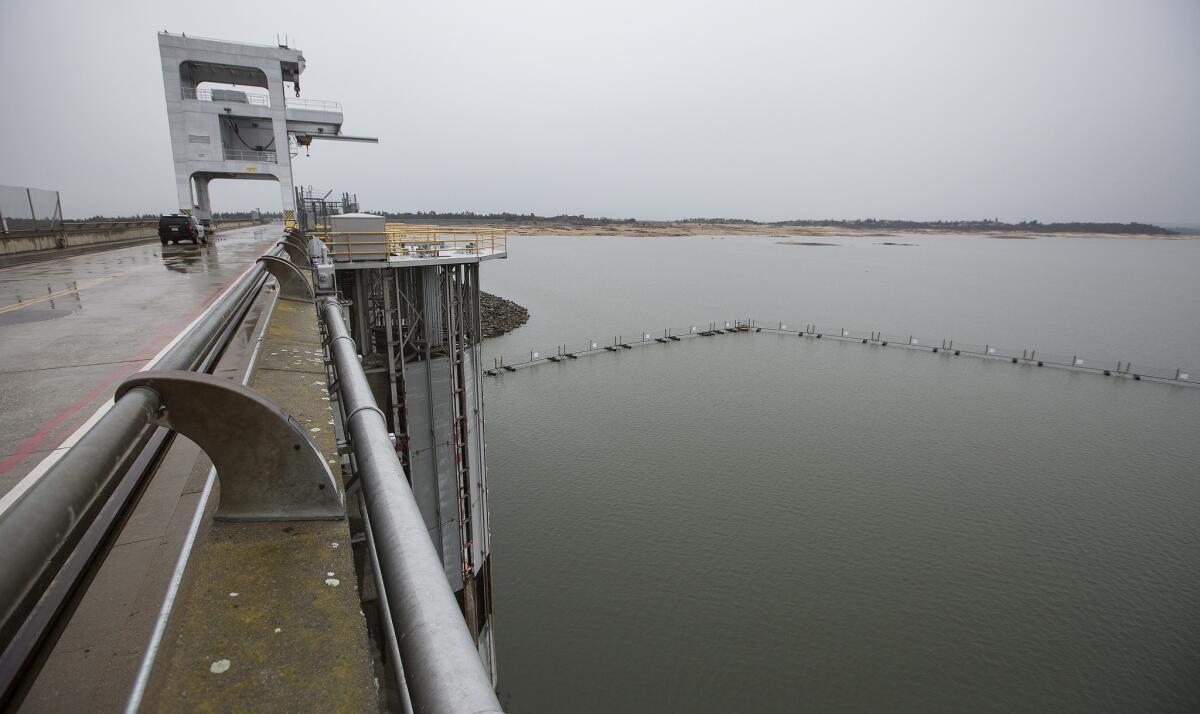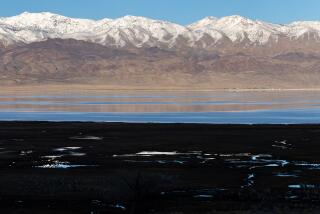Reservoirs are getting a big boost from ‘Miracle March’ — but the drought isn’t over yet

Folsom Dam on the American River at Folsom Lake.
So much rain has fallen in Northern California recently that federal officials have done what would have been unthinkable a year ago. They opened the spill gates at Folsom Lake and let precious water tumble into the American River as a precaution against — of all things — flooding.
A series of storms during this “Miracle March” has caused Folsom and two of its neighbors, Lake Oroville and Shasta Lake, to swell. The massive reservoirs are at above-average levels for the first time since the spring of 2013.
But experts say subsequent reports of the drought’s demise have been exaggerated. With the state’s most-telling snowpack measurement less than two weeks away, California can boast little more than an average year of rain and snow.
“Better than last two, but not as good as we’d like it to be,” said Jay Lund, a professor of civil and environmental engineering at UC Davis who studies water resource management.
Even with the recent rains, reservoir storage statewide remains below average. Although the state’s snowpack is much improved, it also remains below normal, and groundwater in the San Joaquin Valley is still critically overdrafted, as it has been for decades.
The situation leaves regulators in something akin to drought purgatory. As they form their battle plan for 2016, officials must prod Californians to keep conserving even as they consider softening water-use restrictions and watch lawns turn green again.
“We are really in that awkward time,” Lund said. “Is it drought? Is it not drought? What should we be doing? I don’t think anybody is precisely sure.”
For much of the fall, Californians clung to the hope that a “Godzilla” El Niño would wipe out the drought altogether, flooding Southern California and dousing crucial northern regions with enough precipitation to put an end to short showers and fallowed fields.
El Niño arrived, though less violently than expected — drenching Northern California but not the Southland. At eight tracking stations in the Northern Sierra, 14 inches of rain have already fallen in March — more than double the average for the entire month. Overall, the area has seen about 129% of average precipitation.
Because of the way California’s water system is set up, the rain in the Sierra Nevada has been more helpful than it would have been in Los Angeles, but not nearly enough to dig California out of a four-year deficit.
“I’ve seen tweet after tweet saying ‘Hallelujah — look at all the rain we’ve got!’” said Peter Gleick, president of the Pacific Institute, a water think tank based in Oakland. “It’s been so long since we have had even an average year that people are excited.… But one average year isn’t enough.”
This month’s rains have bumped the 154 reservoirs tracked by the state up from about 17 million acre-feet of stored water at the end of February to about 21.5 million acre-feet now, said state hydrologist Maurice Roos. That puts California at about 81% of the end-of-March-average, he said.
The water content in the state’s snowpack is also important because when the snow melts, the water runs off into the reservoirs. The snowpack on Thursday stood at 92% of normal and is expected to still be slightly below average when surveyors perform their March 30 measurement.
A few weeks or even months of rain also cannot undo years of groundwater depletion in the San Joaquin Valley, where desperate locals have drilled deeper and deeper wells. Many people in those hardest-hit areas are not connected to the major water projects that the Northern California storms feed, said Jeanine Jones, the interstate resources manager for the Department of Water Resources.
The State Water Resources Control Board has already had to fund dozens of emergency actions to get people in those predicaments clean drinking water.
“Drought, its presence or absence, is really about how people perceive impacts,” Jones said. “It’s not over.”
Some growers have gotten no water at all from the federal Central Valley Project each of the last two years. The federal Bureau of Reclamation could release its initial allocation for 2016 by the end of the month, said spokesman Shane Hunt. But he cautioned that even after the recent storms, “it is likely to still be a tough year.”
“There’s water up north, but that doesn’t mean it’s where it’s needed for everybody,” Hunt said. “It’s very much a mixed bag across the Central Valley Project.”
The State Water Project is faring better. On Thursday, the Department of Water Resources increased its allocation from 30% to 45%, citing the boosted reservoir levels.
One sector the improved hydrology could help is urban California. Under orders from Gov. Jerry Brown, people in cities and towns across the state have had to slash consumption 25% over the last nine months. As that period wound to a close, regulators approved various conservation credits and adjustments for suppliers, essentially lowering that target by a few percentage points.
State staff members will report to the water board in April on drought conditions and propose next steps, board Chairwoman Felicia Marcus said. Just about everything is on the table, she added.
“The only thing I’m comfortable saying is that we’re probably going to do something,” Marcus said. “We’ve gotten enough precipitation that we’re not going to tighten” the regulations.
“We’re hoping to at least be able to take a breath,” Marcus added. “We probably won’t be able to declare victory.”
The Pacific Institute’s Gleick said it would be a “big mistake” for state water regulators to abandon the emergency conservation program altogether. State data, he said, have shown conservation efforts are already declining “because people have seen it rain.”
Lund, the UC Davis professor, said the weather has thrust state officials like Marcus into “an inherently difficult position” as they try to explain the complex situation.
“You have some responsibility for making sure that if next year is dry again … we save some of the water and keep a little pressure on,” Lund said. “But on the other hand, there’s the chance [that we are] coming to the end of the drought.
“They have a tough, tough balancing act,” he continued. “You can’t win, really.”
Twitter: @bymattstevens
ALSO
Pluto is defying scientists’ expectations in so many ways
UC Merced attacker was inspired by Islamic State, FBI says
Worker dies after falling 53 stories from downtown L.A. high-rise
More to Read
Sign up for Essential California
The most important California stories and recommendations in your inbox every morning.
You may occasionally receive promotional content from the Los Angeles Times.











